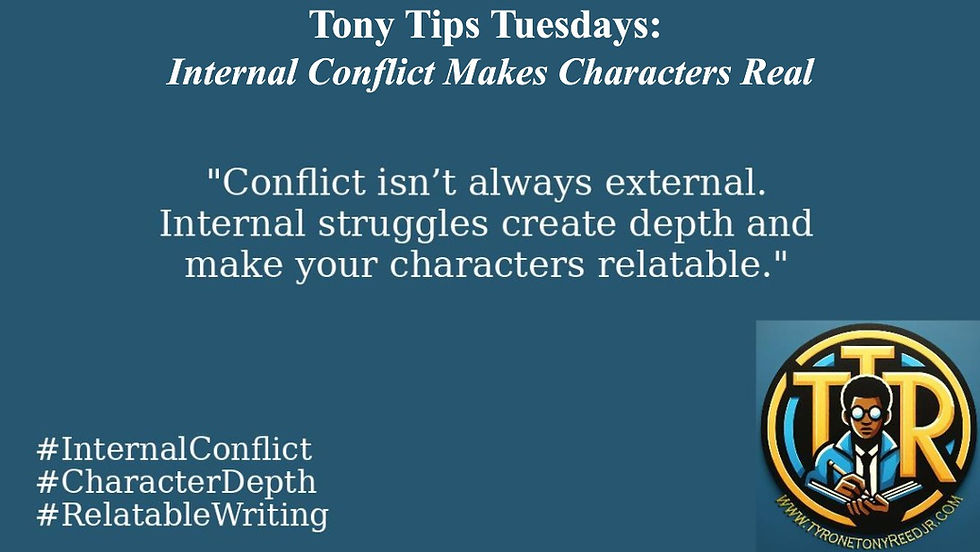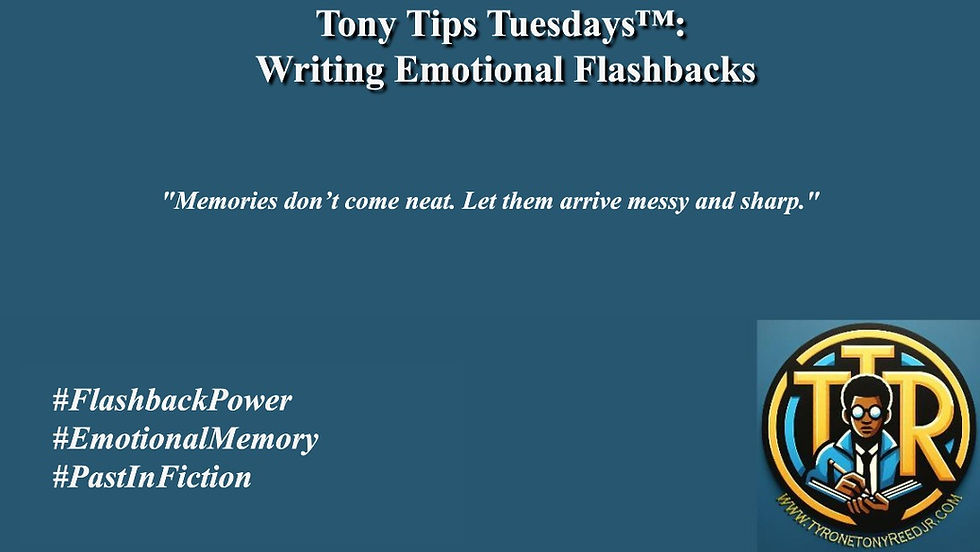Tony Tips Tuesdays: Internal Conflict Makes Characters Real
- Tyrone Tony Reed Jr.

- May 6
- 3 min read

Welcome to this week’s Tony Tips Tuesdays, where we dive into one of the most powerful and often overlooked elements in storytelling: internal conflict. As writers, we often chase the big plot twists, the enemy confrontations, and the external stakes. But the truth is, what makes a story resonate—what makes a character stay with us long after we’ve turned the last page—is what they battle within.
Why Internal Conflict Matters
External threats are visible, measurable. But internal conflict? That’s where your reader finds themselves in the character. Whether it’s fear, guilt, shame, indecision, pride, doubt, or grief—these inner tensions are what mirror our real-world experiences.
Readers connect most with characters who are layered—who love and fear in equal measure, who doubt themselves even as they try to save the world, who feel torn between duty and desire. That’s where depth is born.
A well-developed internal conflict:
Fuels your character’s decisions
Drives the emotional arc
Creates tension even in quiet moments
Makes the resolution feel earned
Examples of Internal Conflict in Literature and Film
Frodo in The Lord of the Rings
His external goal is to destroy the Ring. But his internal battle is staying pure in the face of immense power. The weight of the Ring mirrors the weight of guilt, fear, and temptation. This duality is what makes his journey emotionally gripping.
Celie in The Color Purple
Her external world is full of oppression and abuse. But internally, she struggles to believe she is worthy of love and voice. Her emotional evolution—from silence to self-love—is what makes the story revolutionary.
T’Challa in Black Panther
His conflict isn’t just with Killmonger. It’s within himself—should he uphold tradition or challenge it for a better future? His growth is internal just as much as it is external.
Juanita in S.O.L.A.D.™: Soldiers of Light Against Darkness™
Juanita Grayson battles alongside Kevin and the other Soldiers against forces of darkness. But her truest struggle lies in the grief and uncertainty of who she is becoming. Her inner dialogue—the doubt about her place in the mission, the fear of loss, and the quiet strength she draws from faith—adds layers to her heroism. Her power doesn’t come from being perfect—it comes from continuing despite the fear.
This inner journey allows readers to see their own fears and dreams reflected in Juanita’s strength. She doesn’t always have the answers, but she shows up, guided by love, purpose, and spiritual resolve.
How to Weave Internal Conflict into Your Writing
1. Know Your Character’s Core Wound
What past experience, lie, or belief shapes how they see the world? Maybe they believe they’re not enough. Or they fear abandonment. Or they crave validation. This becomes the lens through which they see every situation.
2. Let Their Choices Reveal Their Conflict
Don’t tell us your character is afraid—show it. Make them hesitate before opening the door. Make them rehearse the conversation before speaking. Use their actions to echo their inner storm.
3. Raise the Stakes by Raising the Emotional Cost
If they fail, what will they lose emotionally? Trust? Self-respect? A chance at forgiveness? Let the emotional fallout of decisions have real consequences.
4. Allow Growth, Not Just Victory
Resolution doesn’t mean all is perfect. It means they’ve changed. Maybe they still fear rejection, but they choose to speak anyway. Maybe they still carry guilt, but they refuse to let it rule them. Growth is the true arc.
Writing Exercises: Building Inner Worlds
Exercise 1: The Lie They Believe
Write a paragraph about the biggest lie your character believes about themselves. Where did it come from? How does it affect their behavior?
Exercise 2: The Moment of Doubt
Craft a scene where your character is alone, grappling with a choice. Let the inner monologue take center stage. No dialogue. No action. Just internal battle.
Exercise 3: Emotional Mirror
Have another character reflect your protagonist’s internal conflict back at them through confrontation or compassion. Let that moment crack them open.
Final Thought: Conflict is the Mirror
Your character’s inner conflict is a mirror. It shows us what we wrestle with. What we run from. What we hope for.
And when we see them grow, we start to believe we can too.
So don’t be afraid to go inward. The most powerful stories aren’t the loudest. They’re the most honest.
Until next Tuesday, keep digging deep and writing true.
📚 Ready to be inspired by faith-filled, purpose-driven storytelling? Order your copy of S.O.L.A.D.™: Soldiers of Light Against Darkness™ and other novels by Tyrone Tony Reed Jr. at www.tyronetonyreedjr.com.
#TonyTips #InternalConflict #CharacterDevelopment #Juanita #WritersJourney #EmotionalArc #SOLAD #RelatableWriting #SoldiersofLightAgainstDarkness #TyroneTonyReedJr #TTR #Conflict



Comments